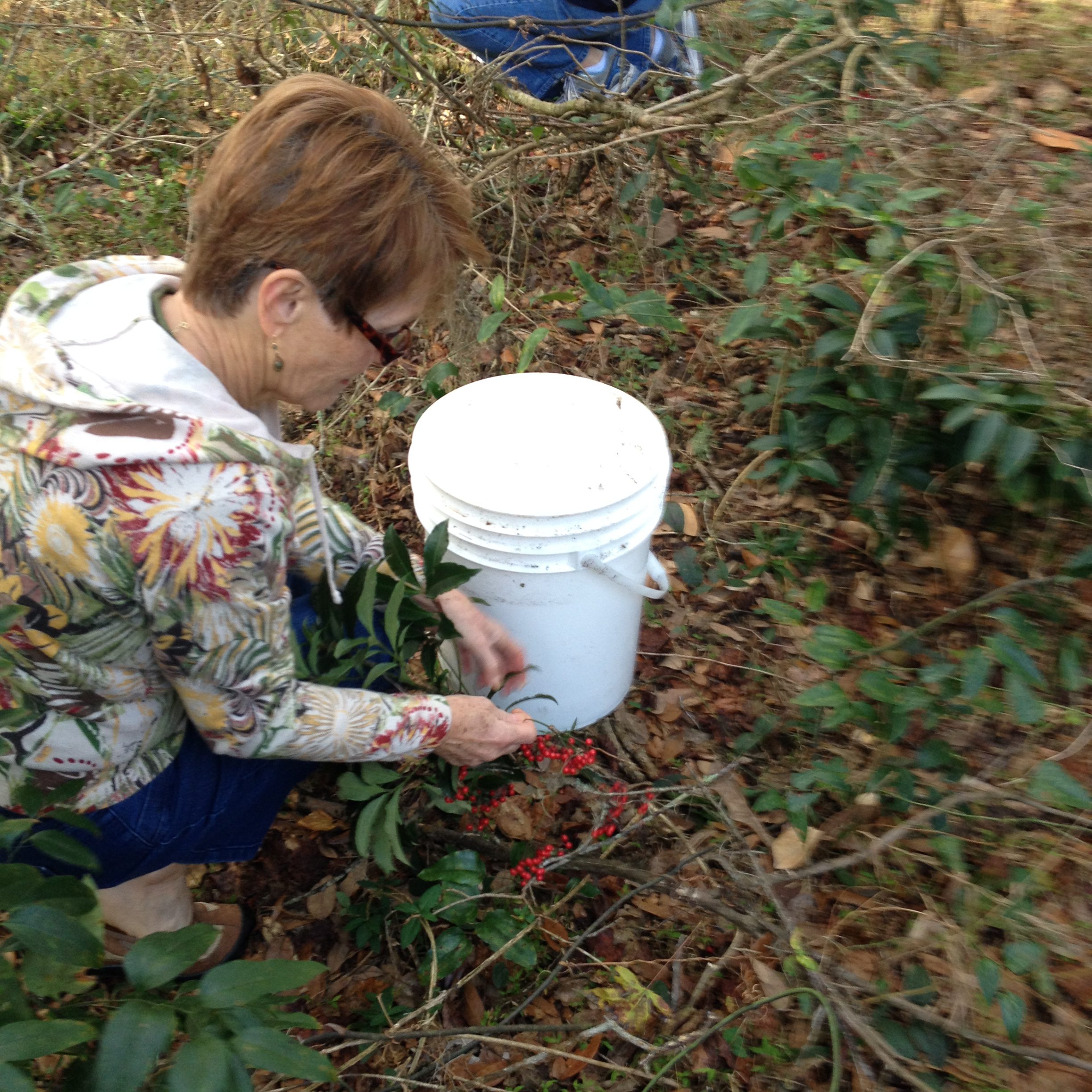
by Mark Tancig | Feb 5, 2018
An important skill for the Florida gardener is to be able to identify and control invasive, exotic plant species. These plants invade and disrupt Florida’s unique natural ecosystems, often spreading from surrounding urban and suburban landscapes. Being proactive in reducing their spread helps protect the integrity of Florida’s natural areas. Cooler days, fewer bugs, dormant vegetation (including poison ivy!), and striking plant characteristics make this time of year perfect for identifying and controlling invasive, exotic plants in urban/suburban woodlands. For additional motivation, February 26 through March 2 has been proclaimed National Invasive Species Awareness Week.
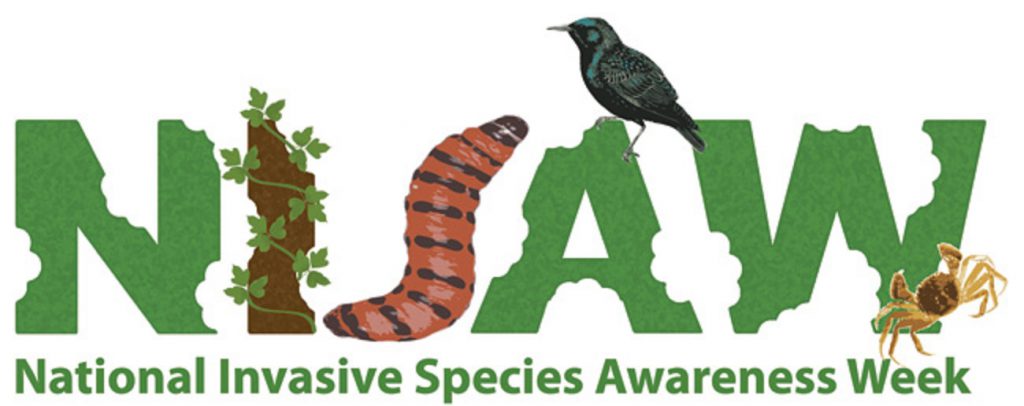
National Invasive Species Awareness Week is February 26 to March 2 this year.
In north Florida, two easily recognizable invasive, exotic plants are coral Ardisia (Ardisia crenata) and heavenly bamboo (Nandina domestica). Both of these plants were introduced decades ago as ornamental plants due to their showy foliage and fruit and ease of cultivation. I picture an adventuring botanist or gardener returning from some exotic locale and sharing what a beautiful and easy growing plant they had found. These characteristics make them easy to notice.
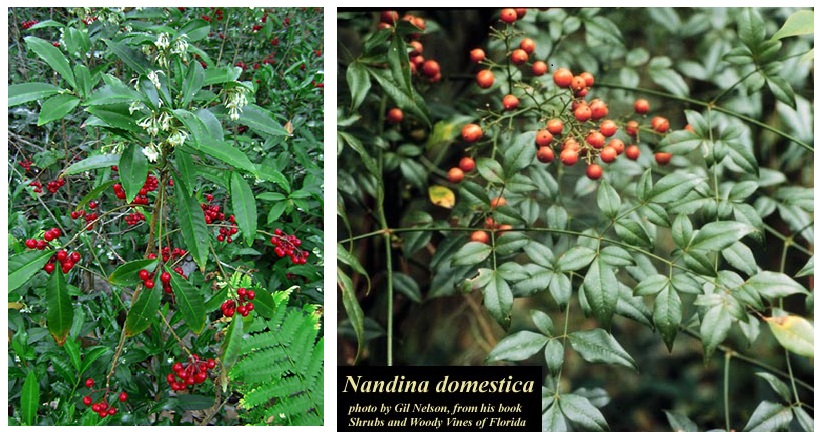
Coral Ardisia (left) and heavenly bamboo (right) are easy to recognize this time of year. Credit: UF/IFAS; Gil Nelson.
In small areas, manual control methods can be used to successfully rid an area of these common pest plants. Simply pick off the berries and place them in a small container – a 5-gallon bucket works great. Pull up the mature plant being sure to remove the roots. The seeds should be double-bagged and placed in the garbage for disposal in a landfill. The plants can be tossed to the side and allowed to dry out and breakdown. For larger plants, a shovel or root jack can be used to help ensure that the roots are removed from the soil. Follow up is often necessary for total control.
Chemical control methods are more efficient and practical for large areas. County Extension offices can help you select the right herbicide control program for your individual site and particular invasive, exotic species present.
During February and leading up to National Invasive Species Awareness Week, look for opportunities in your community to help rid natural areas of these pesky plants. For more information on invasive, exotic species, including photos, videos, and control recommendations, visit the UF/IFAS Center for Aquatic and Invasive Plants website – plants.ifas.ufl.edu.
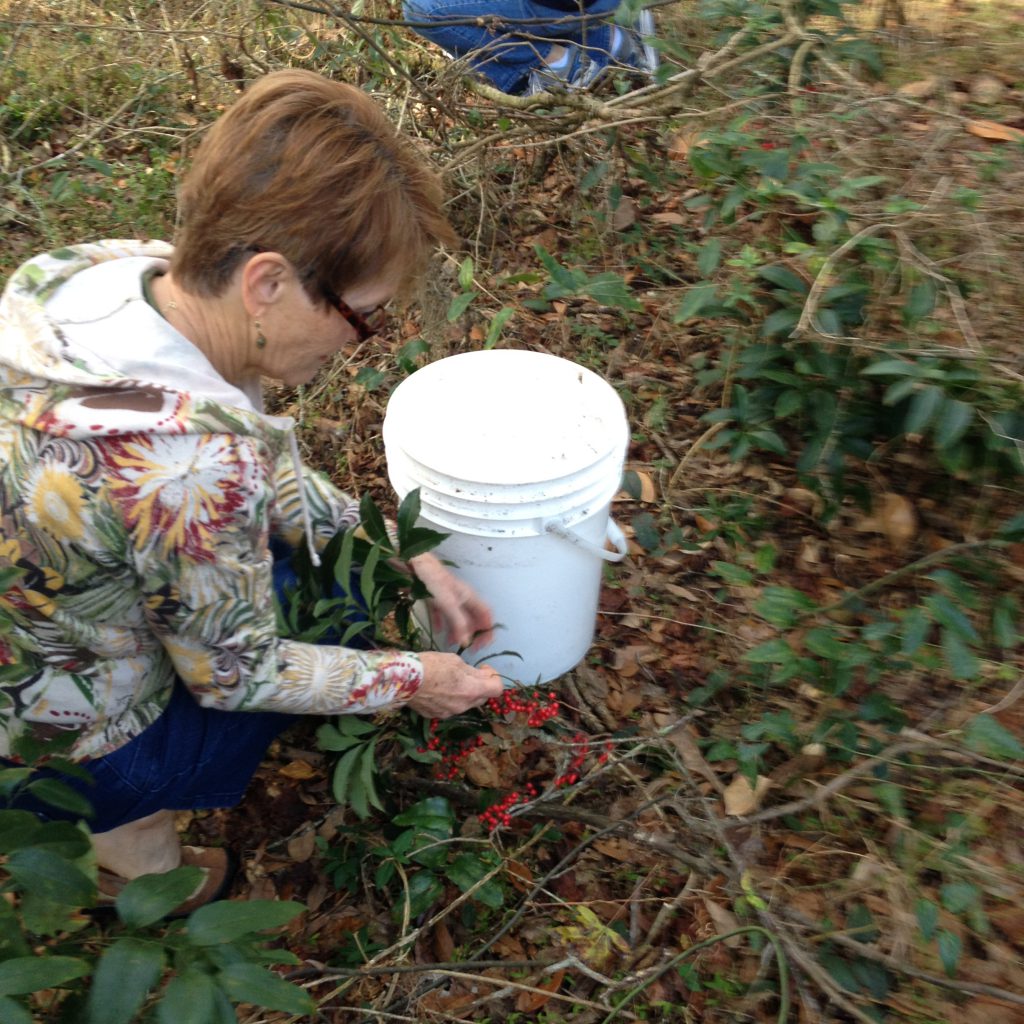
You can help rid local natural areas of invasive, exotic plants. Credit: Mark Tancig
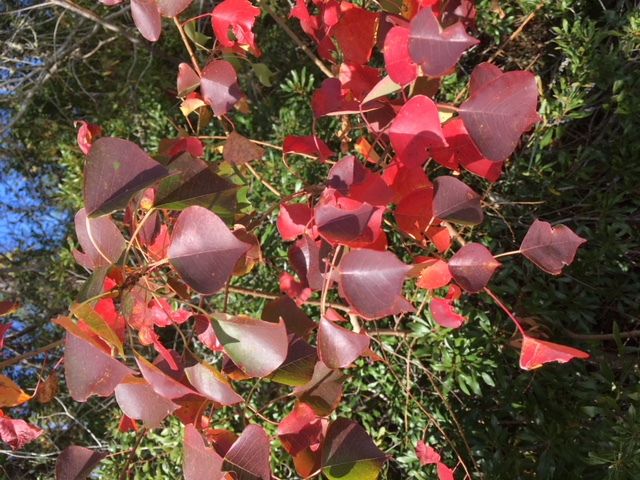
by Julie McConnell | Dec 1, 2017
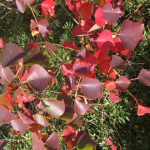
Chinese tallow displays red fall color in North Florida. Photo: J_McConnell, UF/IFAS
In northwest Florida as we transition into fall, we don’t usually see a spectacular display of color change in the forest or our landscapes. Mixed in with the evergreen pines, oaks, and magnolias, we get sporadic spots of yellow and red from our native hickories, sweetgum, and sumac but otherwise it can be rather dull. It’s no wonder that people are reluctant to part with a blaze of red in their landscapes in the form of the invasive Chinese Tallow (Sapium sebiferum L. aka Triadica sebifera L.).
This fast growing, deciduous tree was initially introduced to the United States in 1776 by Benjamin Franklin. It was promoted by the U.S. Department of Agriculture in the early 1900s for the potential to create a soap industry. It was planted as an ornamental because it grows quickly in nearly any type of site condition, has attractive white fruit, and red fall color. Unfortunately, over the years it spread into numerous states and habitats unchecked displacing native vegetation and disrupting wildlife food sources. Eventually, it was recognized as an invasive pest and is currently listed as a noxious weed in Florida, Louisiana, Mississippi, and Texas.
Chinese Tallow is a prolific seed producer and is sexually mature as young as three years and may continue to produce viable seeds to the ripe age of 100. Although some birds eat the berries (part of the dispersal method), sap in the leaves and berries are poisonous to some other animals including cattle.
To prevent the continued spread of this plant, consider removing from your property and replacing with native species. Buy plants from reputable licensed nurseries with good weed management programs. Be able to recognize Chinese Tallow and do not accept plants from well-meaning gardeners who wish to share a foolproof shade tree!
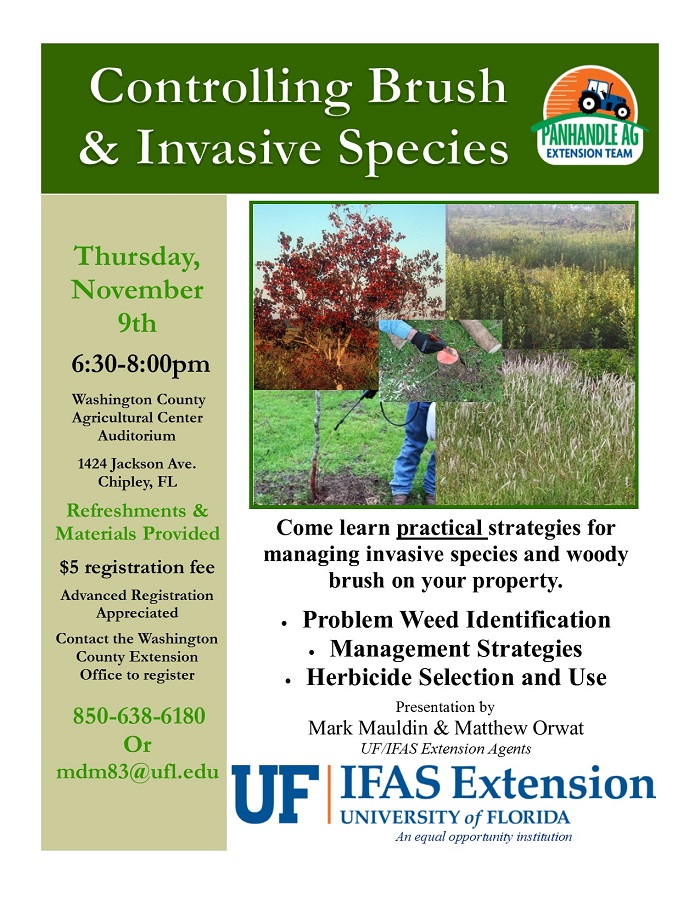
by Matthew Orwat | Oct 26, 2017
Encroaching brush, whether native or invasive, can be a problem for properties large and small. Fighting woody brush and other hard-to-kill weed species can be challenging for property owners. Many factors affect the effectiveness and efficiency of control efforts.
Timing of the application is a key factor that many property owners fail to consider. The cooler, fall and winter months are an excellent time to control a wide variety of troublesome brush species. With this in mind, the Washington County Extension Agents will be presenting a class, Controlling Brush & Invasive Species on November 9, 2017. The class will focus on plant identification and specific chemical control strategies that are effective in the fall and winter months. Herbicide selection and application techniques will be addressed in detail.
Controlling Brush & Invasive Species will be held at the Washington County Agricultural Center (1424 Jackson Ave., Chipley, FL) on Thursday, November 9, 2017 at 6:30 in the evening. Refreshments and printed reference materials will provided. There is a $5 registration fee for the class, payable at the door. Advanced registration for the class is appreciated. If you have questions or would like to register please contact Mark Mauldin at the Washington County Extension Office (850-638-6180 or mdm83@ufl.edu).

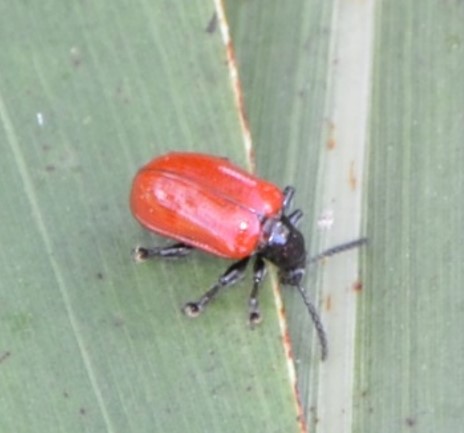
by Les Harrison | Aug 23, 2016
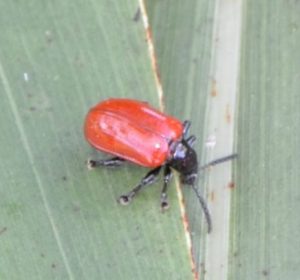
Air potato leaf beetle. Photo credit: Les Harrison, UF/IFAS.
A small, but brightly colored beetle has appeared in north Florida: the air potato leaf beetle (Liliocetis cheni), a native of East Asia. The beetle, less than half an inch long, has a candy apple red body that stands out against green leaves and the more muted earth tones of most other bugs. The striking bright glossy red coating would be the envy of any sports car owner or fire truck driver.
Unlike other arrivals to the U.S., this insect was deliberately released in 2012 for biological control of air potato. After years of testing, approval was finally given to release air potato leaf beetles to begin their foraging campaign against this invasive plant species. The beetle has very specific dietary requirements and only can complete its life cycle on air potato. The larvae and adults of this species consume the leaf tissue and occasionally feed on the tubers.
When a population of air potato leaf beetles finish off an air potato thicket, they go in search of nourishment from the next patch of air potato. They are sometimes seen during stopovers while in search of their next meal.
Air potato (Dioscorea bulbifera) is an herbaceous perennial vine which is easily capable of exceeding 60 feet in length. It quickly will climb over any plant, tree or structure unfortunate enough to be in its vicinity. The vine also produces copious quantities of potato-like tubers suspended from its vines. Unless collected and destroyed, most of the easily camouflaged potatoes will germinate and intensify the infestation.
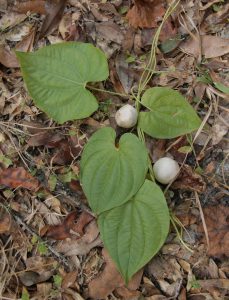
Air potato. UF/IFAS Photo: Thomas Wright.
Air potato came to Florida in 1905 from China and quickly escaped into the wild. By the 1980’s it was a serious pest species in south and central Florida, but has gradually become established in the panhandle, too. Chemical control of the air potato has been difficult. Repeated herbicide treatments are required to kill a thicket with multiple plants.
Unlike the air potato leaf beetle that only eats air potato, kudzu bugs eat their namesake vine (kudzu), but also feed on a number of other plants including a wide selection of valuable legumes and be quite destructive. Kudzu bugs were accidently introduced in north Georgia in 2009 and have spread across the south in the ensuing years and become established in north Florida.
It is a pleasant surprise to know air potato leaf beetles are working to limit the invasive air potato vine, but it is sad to think there is plenty more for them to eat.
To learn more about the air potato and the beetle:
Natural Area Weeds: Air Potato (Dioscorea bulbifera)
Air Potato Leaf Beetle Publication
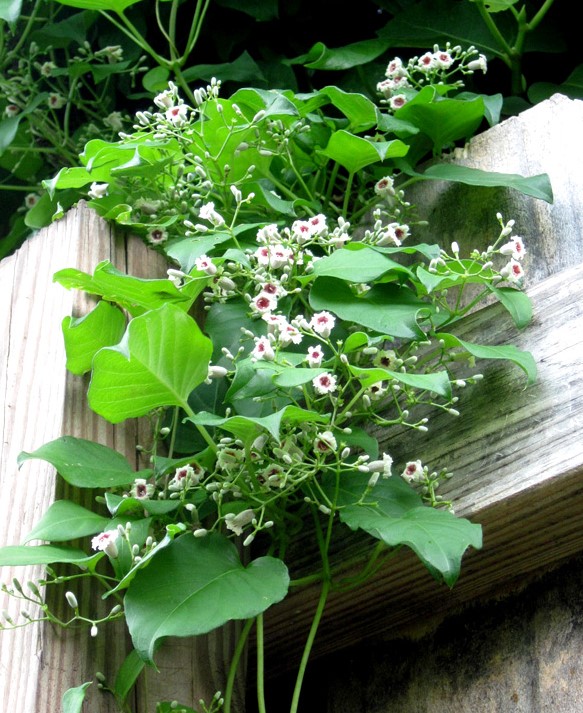
by Mark Tancig | Aug 19, 2016
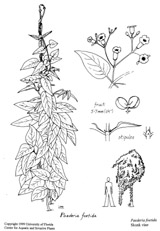
Skunkvine illustration. UF/IFAS Center for Aquatic and Invasive Plants.
North Florida gardeners have many non-native, invasive plants to deal with, but none quite as stinky as skunkvine (Paederia foetida). As the name implies, skunkvine has a noticeable smell, especially when the leaves are crushed, and it is an aggressive-growing vine, capable of smothering desirable landscape plants. Gardeners should learn to recognize and control this plant before it gets a foothold in the garden.
Skunkvine is native to eastern and southern Asia and a member of the coffee family (Rubiaceae). It was introduced to Florida prior to 1897 as a potential fiber crop, but quickly spread and is now considered a Category I invasive plant by the Florida Exotic Pest Plant Council (FLEPPC) and as a noxious weed by the Florida Department of Agriculture and Consumer Sciences (FDACS).
Skunkvine can be identified by the following characteristics:
- Aggressive twining vine
- Leaves are opposite each other
- There is a thin flap of tissue on the stem between the leaves
- Leaves have a strong skunk-like odor when crushed
- Clusters of small, tubular, lilac-colored flowers appear in late summer to fall
- Fruits are shiny brown and can persist through winter
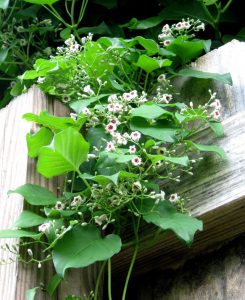
Skunkvine flowering. Photo by Ken Ferrin, UF/IFAS Center for Aquatic and Invasive Plants. Used with permission.
Once you have identified skunkvine in your garden, the next step is to work to remove it. For small patches, pulling by hand can be effective but will require monitoring to ensure it doesn’t resprout. When hand pulling, you want to be sure to get as much of the root as possible. For larger areas, chemical control using herbicide products that contain triclopyr, imazapic, or aminopyralid are most effective. Carefully reading the product label will help determine which product to purchase.
Since skunkvine can be easily spread by seed and fragments of stem, care must be taken when disposing of it. The best solution is to place plant debris into a trash bag and dispose of it with your regular household garbage.
By knowing how to identify and manage skunkvine, north Florida gardeners can keep it from stinking up their own gardens, their neighbor’s gardens, and surrounding natural areas that support our native wildlife.
References:
Langeland, K. A., Stocker, R. K., and Brazis, D. M. 2013. Natural Area Weeds: Skunkvine (Paederia foetida). Agronomy Department, Florida Cooperative Extension Service, Institute of Food and Agricultural Sciences, University of Florida. EDIS document SS-AGR-80.













